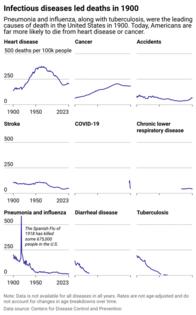From tuberculosis to heart disease: How the leading causes of death in America have changed
Published in Slideshow World
Subscribe
From tuberculosis to heart disease: How the leading causes of death in America have changed
We're all going to die someday. Still, how it happens—and when—can point to a historical moment defined by the scientific advancements and public health programs available at the time to contain disease and prevent accidents.
In the early 1900s, America's efforts to improve sanitation, hygiene, and routine vaccinations were still in their infancy. Maternal and infant mortality rates were high, as were contagious diseases that spread between people and animals.
Combined with the devastation of two World Wars—and the Spanish Flu pandemic in between—the leading causes of death changed significantly after this period. So, too, did the way we diagnose and control the spread of disease.
Starting with reforms as part of Roosevelt's New Deal in the 1930s, massive-scale, federal interventions in the U.S. eventually helped stave off disease transmission. It took comprehensive government programs and the establishment of state and local health agencies to educate the public on preventing disease transmission.
Seemingly simple behavioral shifts, such as handwashing, were critical in thwarting the spread of germs, much like discoveries in medicine, such as vaccines, and increased access to deliver them across geographies. Over the course of the 20th century, life expectancy increased by 56% and is estimated to keep increasing slightly, according to an annual summary of vital statistics published by the American Academy of Pediatrics in 2000.
Death Records examined data from the Centers for Disease Control and Prevention to see how the leading causes of death in America have evolved over time and to pinpoint how some major mortality trends have dropped off.
Visit thestacker.com for similar lists and stories.
Infectious diseases lead causes of death in America
According to a report published in the journal Annual Review of Public Health in 2000, pneumonia was the leading cause of death in the early 1900s, accounting for nearly 1 in 4 deaths.
By the time World War I ended in 1918, during which people and animals were housed together for long periods, a new virus emerged: the Spanish Flu. Originating in a bird before spreading to humans, the virus killed 10 times as many Americans as the war. Many died of secondary pneumonia after the initial infection. Pneumonia deaths eventually plummeted throughout the century, partly prevented by increased flu vaccine uptake rates in high-risk groups, particularly older people.
Per the CDC, tuberculosis was a close second leading cause of death, killing 194 of every 10,000 people in 1900, mainly concentrated in dense urban areas where the infection could more easily spread. Eventually, public health interventions led to drastic declines in mortality from the disease, such as public education, reducing crowded housing, quarantining people with active disease, improving hygiene, and using antibiotics. Once the death rates lagged, so did the public health infrastructure built to control the disease, leading to a resurgence in the mid-1980s.
Diarrhea was the third leading cause of death in 1900, surging every summer among children before the impacts of the pathogen died out in 1930. Adopting water filtration, better nutrition, and improved refrigeration were all associated with its decline.
In the 1940s and 1950s, polio outbreaks killed or paralyzed upward of half a million people worldwide every year. Even at its peak, polio wasn't a leading cause of death, it was a much-feared one, particularly among parents of young children, some of whom kept them from crowded public places and interacting with other children.
By 1955, when Jonah Salk discovered the polio vaccine, the U.S. had ended the "golden age of medicine." During this period, the causes of mortality shifted dramatically as scientists worldwide began to collaborate on infectious disease control, surgical techniques, vaccines, and other drugs.
Leading causes of death tip toward lifestyle-related disease
From the 1950s onward, once quick-spreading deadly contagionsweren't prematurely killing American residents en masse, scientists also began to understand better how to diagnose and treat these diseases. As a result, Americans were living longer lives and instead succumbing to noncommunicable diseases, or NCDs.
The risk of chronic diseases increased with age and, in some cases, was exacerbated by unhealthy lifestyles. Cancer and heart disease shot up across the century, increasing 90-fold from 1900 to 1998, according to CDC data.
Following the post-Spanish Flu years, heart disease killed more Americans than any other cause, peaking in the 1960s and contributing to 1 in 3 deaths. Cigarette smoking rates peaked at the same time, a major risk factor for heart disease. Obesity rates also rose, creating another risk factor for heart disease and many types of cancers.
This coincides with the introduction of ultra-processed foods into diets, which plays a more significant role in larger waistlines than the increasing predominance of sedentary work and lifestyles.
In the early 1970s, deaths from heart disease began to fall as more Americans prevented and managed their risk factors, like quitting smoking or taking blood pressure medicine. However, the disease remains the biggest killer of Americans.
Cancer remains the second leading cause of death and rates still indicate an upward trajectory over time. Only a few types of cancer are detected early by screening, and some treatments for aggressive cancers like glioblastoma—the most common type of brain cancer—have also stalled, unable to improve prognosis much over time.
In recent years, early-onset cancers, those diagnosed before age 50 or sometimes even earlier, have seen a drastic rise among younger Americans. While highly processed foods and sedentary lifestyles may contribute to rising rates, a spike in cancer rates among otherwise healthy young individuals has baffled some medical professionals.
This follows the COVID-19 pandemic that began in 2020. At its peak, high transmission rates made the virus the third leading cause of death in America. It's often compared to the Spanish Flu of 1918, though COVID-19 had a far larger global impact, spurring international collaborations among scientists who developed a vaccine in an unprecedented time.
Public policy around issues of safety and access also influences causes of death, particularly—and tragically—among young Americans. Gun control measures in the U.S. are far less stringent than in peer nations; compared to other nations, however, the U.S. leads in gun violence. Firearms are the leading cause of death for children and teens (around 2 in 3 are homicides, and 1 in 3 are suicides), and deaths from opioids remain a leading cause of death among younger people.
Globally, the leading causes of death mirror differences in social and geographic factors. NCDs are primarily associated with socio-economic status and comprise 7 out of 10 leading causes of death, 85% of those occurring in low- and middle-income countries, according to the World Health Organization.
However, one of the best health measures is life expectancy at birth. People in the U.S. have been living longer lives since 2000, except for a slight dip in longevity due to COVID-19. According to the most recent CDC estimates, Americans' life expectancy is 77.5 years on average and is expected to increase slightly in the coming decades.
Story editing by Alizah Salario. Additional editing by Kelly Glass. Copy editing by Paris Close. Photo selection by Lacy Kerrick.
This story originally appeared on Death Records and was produced and distributed in partnership with Stacker Studio.









Comments